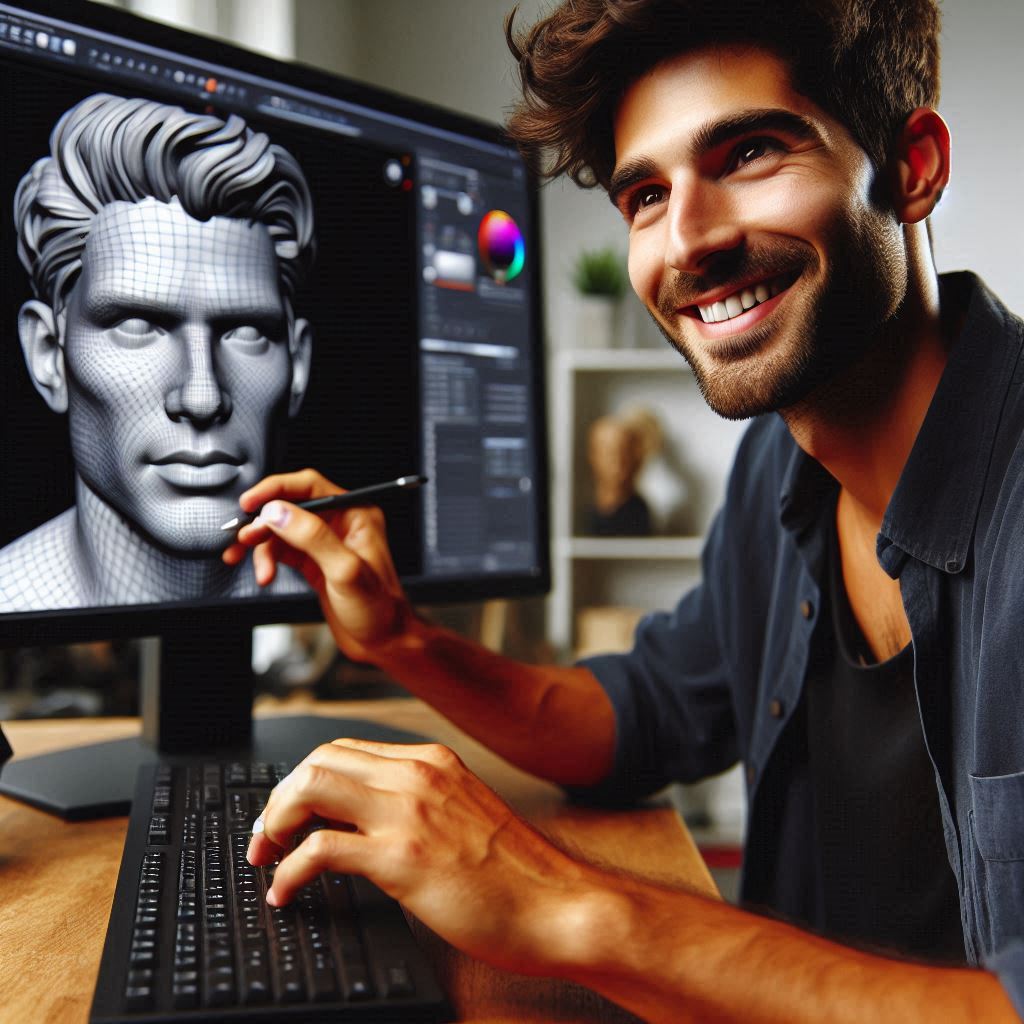Introduction
Digital sculpting merges traditional art techniques with cutting-edge technology.
This innovative process allows artists to create three-dimensional models using software.
Unlike traditional sculpting, digital sculpting offers limitless possibilities.
Artists can manipulate shapes, add details, and make adjustments instantly.
Digital sculpting holds significant importance in various fields.
It plays a crucial role in video game design, film production, and animation.
Artists can develop intricate characters and environments more efficiently than with traditional methods.
The ability to visualize concepts in 3D enhances creativity and flexibility.
Combining art with technology in sculpting opens new avenues for expression.
Artists can experiment with textures, colors, and forms without physical constraints.
This freedom encourages innovation and exploration in their work.
Moreover, digital tools streamline the workflow, allowing artists to focus on creativity.
The rise of digital sculpting has also democratized art creation.
More individuals can access sculpting software and tutorials online.
This accessibility fosters a diverse community of artists, each contributing unique perspectives.
In essence, digital sculpting represents a fascinating blend of art and technology.
It empowers artists to push boundaries and explore new creative landscapes.
As technology continues to evolve, the future of digital sculpting looks promising.
Overview of Digital Sculpting
Definition of Digital Sculpting
Digital sculpting is a form of art where sculptors use digital tools to create 3D sculptures.
It involves manipulating digital clay to shape and mold virtual objects.
Transform Your Career Today
Unlock a personalized career strategy that drives real results. Get tailored advice and a roadmap designed just for you.
Start NowTools and Software Used in Digital Sculpting
Some popular tools and software used in digital sculpting include ZBrush, Mudbox, Blender, and Sculptris.
These programs offer a wide range of features for sculptors to create detailed and intricate designs.
Benefits of Using Digital Sculpting Techniques
- Precision: Digital sculpting allows artists to work with pinpoint accuracy, making it easier to create intricate and detailed designs.
- Time-saving: Unlike traditional sculpting methods, digital sculpting can save artists a significant amount of time by allowing them to quickly make changes and experiment with different designs.
- Cost-effective: Digital sculpting eliminates the need for expensive materials and tools, making it a more affordable option for artists looking to create sculptures.
- Accessibility: With the rise of digital technology, digital sculpting has become more accessible to artists around the world, allowing them to showcase their work on a global platform.
- Versatility: Digital sculpting offers artists a wide range of tools and techniques to explore, allowing them to push the boundaries of traditional sculpting methods and create unique and innovative designs.
In fact, digital sculpting combines the artistry of traditional sculpting with the technological advancements of digital tools, offering artists a new and exciting way to create stunning 3D sculptures.
Whether you’re a seasoned sculptor or a beginner looking to explore new creative avenues, digital sculpting provides endless possibilities for artistic expression.
Read: Art and Design Trends in 2024: What‘s Hot?
Evolution of Sculpting Techniques
Throughout history, sculptors have used various methods to create their masterpieces.
From carving to molding, each technique has its own unique process and challenges.
Traditional sculpting involves physically manipulating materials such as clay, wood, or stone to create a sculpture.
This hands-on approach requires great skill and precision.
On the other hand, digital sculpting utilizes software and technology to create 3D models.
Artists can manipulate virtual materials with tools like ZBrush or Blender.
One key difference is that traditional sculpting is more tangible and allows for a direct connection between the artist and the medium.
Digital sculpting, on the other hand, offers greater flexibility and control over the final product.
Comparison of traditional sculpting methods with digital sculpting
Traditional sculpting requires physical tools and materials, while digital sculpting relies on software and computers.
Traditional sculpting is a more time-consuming process, as artists must physically sculpt each detail.
Digital sculpting can be faster and more efficient, as artists can easily undo mistakes or make changes.
Traditional sculpting can be more predictable in terms of the final result, while digital sculpting allows for more experimentation and creativity.
Both methods require artistic skill and vision, but digital sculpting also requires technical proficiency with software programs.
Advancements in technology that have revolutionized sculpting
Technological advancements have significantly impacted the field of sculpting, especially with the rise of digital sculpting tools.
Showcase Your Business Today
Reach thousands of readers actively exploring professional services. Publish your business profile and grow your audience now.
Publish Now3D printing, for example, has revolutionized the way sculptures are created.
Artists can now print their digital designs in a variety of materials, from plastic to metal.
Virtual reality has also played a role in digital sculpting, allowing artists to immerse themselves in their creations and work in a more intuitive way.
Software like ZBrush and Mudbox have revolutionized digital sculpting by offering powerful tools that simulate real-world sculpting techniques.
Impact of digital sculpting on the art world
Digital sculpting has democratized the art world by making sculpting more accessible to a wider audience.
Artists can now create and share their digital sculptures online, reaching a global audience and gaining recognition for their work.
Digital sculpting has also opened up new possibilities for collaboration, as artists can easily share and modify digital files with others.
The art world has embraced digital sculpting as a legitimate form of artistic expression, with many galleries and museums showcasing digital sculptures alongside traditional ones.
Read: Glass Art: Finding Your Unique Style
Process of Digital Sculpting
Digital sculpting combines art and technology, allowing artists to create intricate sculptures in a virtual environment.
Follow this step-by-step guide to navigate the digital sculpting process.
Step-by-Step Guide to Creating a Digital Sculpture
- Choose Your Software: Select a digital sculpting program like ZBrush, Blender, or Mudbox. Each has unique features.
- Gather References: Collect images and sketches of your subject. This helps maintain accuracy and inspiration.
- Create a Base Mesh: Start with a simple shape to establish proportions. Use basic tools to block out the form.
- Refine the Shape: Gradually add details to your sculpture. Adjust proportions and features as you go.
- Add Texture: Use brushes to create surface details. Experiment with different textures for realism.
- Color and Lighting: Apply colors and set up lighting in your scene. This enhances the visual appeal of your sculpture.
- Export and Render: Once satisfied, export your sculpture for rendering. Save it in a high-quality format.
Importance of Precision and Attention to Detail
Precision and detail are vital in digital sculpting.
Attention to these aspects ensures:
- Realism: Accurate details enhance the sculpture’s lifelike quality.
- Expression: Nuanced features convey emotions and character.
- Quality: High standards attract viewers and potential clients.
Role of Technology in Enhancing the Sculpting Process
Technology revolutionizes the sculpting experience.
Key benefits include:
- Digital Tools: Sculpting software offers brushes and tools that mimic traditional sculpting techniques.
- Undo Feature: Mistakes become easier to correct, allowing for experimentation without fear.
- 3D Printing: Final digital sculptures can be transformed into physical models, bridging the digital and physical realms.
Digital sculpting merges creativity and technology, empowering artists to explore new artistic frontiers.
With the right tools and techniques, anyone can create stunning digital masterpieces.
Read: The Science Behind Glass Art and Design

Combining Artistry with Technology
Digital sculpting allows artists to merge traditional artistry with cutting-edge technology.
By using digital tools, artists can enhance their creative vision, expand their capabilities, and produce high-quality sculptures that were once limited by physical constraints.
Enhancing Creativity with Digital Tools
Digital sculpting tools like ZBrush, Blender, and Autodesk Mudbox provide artists with powerful features.
These tools allow:
- Sculpting with precision
- Creating complex textures effortlessly
- Undoing mistakes without damaging the project
With these features, artists can experiment freely, resulting in more innovative and imaginative sculptures.
Balancing Artistic Expression with Technical Skills
While digital tools offer enhanced capabilities, artists must balance artistic expression with technical know-how.
Mastering these skills ensures that their creative vision isn’t compromised by the medium.
To achieve this balance, artists should focus on:
- Learning the core principles of traditional sculpting
- Understanding the technical functions of the chosen software
- Practicing continuously to improve precision and technique
The ability to balance creativity and technical expertise is crucial for success in digital sculpting.
Examples of Successful Digital Sculptors
Several digital sculptors have mastered the combination of art and technology, paving the way for the next generation of artists:
- Rafael Grassetti: A renowned digital sculptor known for his work in video games and character design.
- Kris Costa: Famous for his hyper-realistic digital sculptures and contributions to the film industry.
- Scott Eaton: A digital sculptor who merges art, anatomy, and technology to create striking sculptures.
These artists demonstrate how effectively blending technology with artistic skill can produce groundbreaking results.
Digital sculpting represents a new frontier in the art world.
By combining artistry with technology, sculptors can explore new creative possibilities and produce works that push the boundaries of their craft.
With the right balance of creativity and technical skills, artists can achieve their full potential.
Read: Art and Design Careers: What You Need to Know
See Related Content: Top Tools for Interactive Media Design
Challenges and Limitations of Digital Sculpting
In the world of digital sculpting, artists face various challenges that can impact their creative process and final output.
Common Difficulties Faced by Digital Sculptors
Mastering complex software tools can be overwhelming for beginners.
Converting a 2D concept into a 3D sculpture requires a different skill set.
Managing large amounts of data and high-resolution files can slow down the workflow.
Technical issues such as software glitches or hardware limitations can disrupt the creative flow.
Creating realistic textures and materials can be challenging without proper training or experience.
Showcase Your Business Today
Reach thousands of readers actively exploring professional services. Publish your business profile and grow your audience now.
Publish NowThe impact of technology on the artistic process
Advancements in technology have revolutionized the way artists approach sculpting.
Digital tools offer new possibilities and creative freedom but also come with their own set of limitations.
Increased efficiency and speed in the sculpting process.
Ability to easily undo mistakes and experiment with different ideas.
Integration of digital sculpting with other software for a seamless workflow.
Lack of physical feedback compared to traditional sculpting techniques.
Dependence on technological devices and software updates for optimal performance.
Participating in online communities and forums to share knowledge and learn from fellow artists.
Future trends in digital sculpting and how artists are adapting to new challenges
As technology continues to evolve, digital sculptors are finding innovative ways to overcome obstacles and push the boundaries of their craft.
Exploring virtual reality and augmented reality tools for immersive sculpting experiences.
Collaborating with programmers and engineers to develop custom tools for specific artistic needs.
Embracing machine learning and artificial intelligence for automated sculpting tasks.
Experimenting with new materials and fabrication techniques for unique sculptural forms.
Case Studies and Examples
Showcase of digital sculpting projects from renowned artists
Showcasing digital sculpting projects from renowned artists can provide valuable insight into their creative process.
One such example is the work of ZBrush artist, Ryan Kingslien, who is known for his intricate character designs.
His use of digital sculpting tools allows him to bring his imaginative creations to life in a way that traditional sculptors could only dream of.
Another artist worth mentioning is Kris Costa, whose digital sculptures blur the line between fantasy and reality.
Through the use of advanced software like Blender and Mudbox, Costa is able to manipulate digital clay with precision and detail that is simply awe-inspiring.
These examples demonstrate the endless possibilities that digital sculpting offers to artists looking to push the boundaries of their creativity.
By studying the work of these masters, aspiring digital sculptors can gain valuable insights into the techniques and tools used to create stunning sculptures.
Techniques used in creating digital sculptures
One of the key techniques used in digital sculpting is the process of layering.
By creating multiple layers of digital clay, artists can easily manipulate and refine their sculptures without damaging the base structure.
This allows for a level of precision and control that is unmatched in traditional sculpting methods.
Another important technique is the use of digital brushes, which allow artists to sculpt in a way that mimics traditional sculpting tools.
With tools like the clay buildup brush and the smooth brush, sculptors can create intricate details and smooth surfaces with ease.
Additionally, the use of texturing and painting techniques can add depth and realism to digital sculptures.
By carefully applying textures and colors to their creations, artists can bring their sculptures to life in a way that is visually stunning.
Inspiration for aspiring digital sculptors to explore new creative possibilities
For aspiring digital sculptors, the world of digital sculpting offers endless opportunities for creative exploration.
By experimenting with different tools and techniques, artists can push the boundaries of what is possible in the world of sculpture.
One way to find inspiration is to study the work of established digital sculptors and analyze their techniques.
By understanding how these artists approach sculpting in the digital realm, aspiring sculptors can gain valuable insights into how to improve their own work.
Additionally, participating in digital sculpting communities and forums can provide a supportive environment for artists to share ideas, techniques, and feedback.
By connecting with other artists, aspiring sculptors can cultivate a network of peers who can provide valuable guidance and inspiration.
Conclusion
It is evident that combining art with technology in sculpting opens up endless possibilities for creativity and innovation.
Artists have the opportunity to push the boundaries of traditional sculpting techniques and explore new horizons.
Encouraging artists to embrace digital sculpting not only enhances their artistic expression but also provides them with a platform to showcase their unique style and vision to a wider audience.
As we look towards the future, digital sculpting is poised to play a significant role in the art world.
It offers a new dimension for artists to experiment, collaborate, and create works that push the boundaries of what is possible in the realm of sculpture.
[E-Books for Sale]
The Big Book of 500 High-Paying Jobs in America: Unlock Your Earning Potential
$19.99 • 500 High-Paying Jobs • 330 pages
Explore 500 high-paying jobs in America and learn how to boost your career, earn more, and achieve success!
See All 500 High-Paying Jobs of this E-Book
1001 Professions Without a Degree: High-Paying American Jobs You Can Start Now
$19.99 • 1001 Professions Without a Degree • 174 pages
Discover 1001 high-paying jobs without a degree! Unlock career tips, skills, and success strategies for just $19.99!




